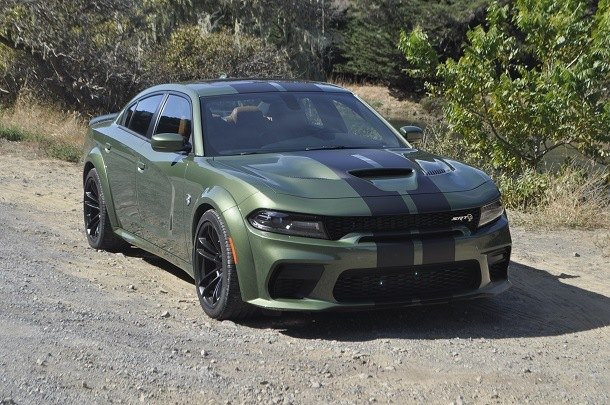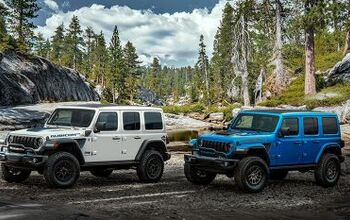2020 Dodge Charger Hellcat and Scat Pack Widebody First Drive - Family 'Haul'-er

No one has a need for a large family sedan that produces over 700 horsepower.
But I’m glad one exists.
Dodge is now offering a wider Charger Hellcat and Scat Pack in a bid to keep reminding us enthusiasts that the Charger’s aging platform may still have plenty of life left in it. Somehow, this trick continues to work.
(Full disclosure: Dodge flew me to San Francisco, put me in a nice hotel in Napa, and fed me wine and food. They also gave us a few laps at Sonoma Raceway under the guidance of pro instructors. They offered a hat, which I did not take home.)
Hellcats now come standard in Widebody guise, and Scat Packs are available as such. This new exterior offers different front and rear fascias, integrated fender flares, wider wheels and tires, and 3.5 inches in increased overall width.
Wider wheels – 11 inches wide compared to 9.5 on previous Hellcats/some Scat Packs and 9 on previous and current regular-body Scat Packs – host wider (compared to 245 (Scat Pack)/275 (Hellcats and Scat Packs with certain option packages)) 305/35ZR20 tires. Up front sit six-piston brake calipers and two-piece front brake rotors.
The suspension from Bilstein gets special tuning to go along with three-mode adaptive damping. There’s also front spring rates that are 32 percent stiffer than the previous model, larger sway bars (from 32 mm to 34 mm up front, and 19 mm to 22 mm out back), and re-tuned shocks with revised valving. That last bit is done so the shocks and springs work better together. Electric power steering with selectable steering tuning is now standard.
Drive modes include Street, Sport, Track, and Custom. As per SRT custom, drivers can use the infotainment system to control settings for horsepower, transmission shift speeds, steering, traction, suspension, and the paddle shifters. Both cars are equipped with so-called Performance Pages, allowing drivers to fool around with all sorts of data.
Other track tech includes line lock, launch control, line assist (meant to mitigate wheel hop), and a cool-down feature that runs the intercooler pump and radiator fan even after engine shut-off.
Hellcats continue to put out 707 horsepower (717 with the optional Daytona package) and 650 lb-ft of torque from the 6.2-liter supercharged V8 under hood, and that power gets to ground via an eight-speed automatic transmission. Scat Pack uses a 6.4-liter naturally aspirated V8 that makes 485 horsepower and 475 lb-ft of torque, and also mates to an eight-speed automatic transmission.
Interior changes are minor, save for unique accents and logos. Heated and cooled seats and a heated steering wheel are standard.
Both cars run Pirelli rubber, with the Scat Pack offering the same 20-inch wheels and 305/35ZR20 tire size and the same 11-inch wheel width. There’s an optional Carbon Black finish for the rims on the Scat Pack, while the Hellcat offers two optional finishes. While standard tires for both vehicles are all-seasons, three-season tires are available for both.
Like the Hellcat, the Scat Pack gets a modified suspension. Springs, sway bars, and shocks are all changed. The front spring rate is 27 percent stiffer, the rear sway bar is now 22 mm instead of 19, and the damper calibration is changed to match up with all the other alterations.
Line lock, launch control, and launch assist are standard.
For those curious about numbers, Dodge claims the Hellcat Widebody accelerates from 0-60 mph in 3.6 seconds and does the quarter-mile in 10.96 seconds, while the Scat Pack does the 0-60 run in 4.3 seconds and runs the quarter in 12.4 seconds. Both cars come close to 1.0 g on the skidpad – 0.96 for the Hellcat and 0.98 for the Scat Pack. We don’t have the type of equipment we’d need to validate these numbers, but they seem about right.
When we got done with the usual press-trip minutiae — breakfast, presentation/presser, et cetera – and the car minders finally tossed keys to journos (red keys, hallelujah — no horsepower limitations), the exhaust rumbles of the gathered Hellcats and Scat Packs seemed like they’d be audible, even at idle, all the way down in San Francisco.
Indeed, the exhaust is so America, f*ck yeah!, you expect the pipes to start belching out bald eagles.
My day started behind the wheel of the Hellcat, which my drive partner and I wheeled out of Sonoma Raceway heading vaguely northwest towards the ocean, using some of the same roads I just drove a few weeks earlier while testing Ford’s High Performance Package four-cylinder Mustang. The Hellcat rode well on California’s mostly pristine pavement, and it felt buttoned-down, well-planted, and stable even in tighter corners, although the car’s width did sometimes make the lanes feel narrow.
From the driver’s seat, the deep rumble of the Hellcat’s exhaust is complimented by the supercharger whine that pops up whenever the throttle is applied with any real amount of force. Even with the electric steering, the feel was well-weighted, offering only a hint of artificial feel.
When it comes to throttle applications, I was gentle – traffic was a bit heavy, and I wanted no unplanned conversations with local law enforcement. Especially with track time planned for later in the afternoon. Perhaps the fact that I ended up with a much lighter wallet the last time I was loaned a Hellcat press car (while also needing to devote time to online traffic school) was in the back of my mind.
Hellcat unleashed on track, I was reminded that all that power/torque has a way of shortening straightaways (which aren’t all that long at Sonoma to begin with), and the Brembos did their job nicely. I built speed as I got to know the track better, and the Chargers (I drove a Hellcat twice, as well as a Scat Pack twice, no chance to drive a Daytona package car) all felt stable and planted in corners, with little drama. Both cars felt more svelte than their size suggests, and while I knew I needed to stay patient before digging into the throttle, I was never intimidated.
The Scat Pack weighs about 200 pounds less than the Hellcat, so turn-in was a tad sharper. Throttle calibration was also tighter, meaning it was a little trickier to apply it smoothly. It also served up a smidge more body roll. That, and the lack of supercharger whine, were the most noticeable on-track differences.
I drove a Scat Pack back to the hotel, and the jumpier throttle, lack of supercharger whine, and lighter weight were noticeable on the street, even while driving relatively gently.
While the Widebody treatment aims to improve handling, it also gives the cars a distinct look. Yeah, you can still tell they’re Chargers from a long way off, but there’s something more sinister about the wider look. Certainly, more than a few heads turned as we toured Sonoma County.
Inside, the minor updates are appreciated but the overall experience is the same as before – plenty of room, seats that are a bit overbolstered for street use, easy-to-use infotainment and HVAC controls. UConnect infotainment with Android Auto, Apple CarPlay, and all that SRT data is standard and housed in an 8.4-inch touchscreen. There’s a 7-inch driver info screen in the gauge cluster.
Other available features (depending on trim) include sunroof, fog lamps, functional hood scoop (with heat extractors in the Hellcat), blind-spot monitoring, rear spoiler, dual-zone climate control, power tilt/telescope steering wheel, multiple USB ports, satellite radio, adaptive cruise control, blind-spot monitoring with rear cross-path alert, brake assist, hill-start assist, forward-collision warning with braking, lane-departure warning with lane-keep assist, rear park assist, keyless entry and starting, navigation, and premium audio.
Fuel economy numbers are not yet available.
The Hellcat I drove started at $69,645. Add in $1,495 for destination, $1,595 for a carbon and suede interior appearance package, another $995 for hood stripes, $1,595 for premium audio, $995 more for an infotainment package including nav, plus $1,995 for the sunroof, and you end up with a $78,315 car. A Daytona Package Hellcat will start at $74,140.
Meanwhile, the Scat Pack I drove started at $39,995. Destination added $1,495, and the Widebody package cost $6,000. Three-season rubber sets the price back another $695, and the red brake calipers added $595. Options and option packages included the Driver Confidence Group ($795), premium audio ($1,595), the navigation package ($995), the Plus package ($1,895), sunroof ($1,295), and Technology Group ($1,895), for a total of $57,250.
The essence of Americana doesn’t come cheap.
As stated at the outset, no one needs either of these cars. So what? Someday soon, market forces and/or changes in the regulatory environment will make these cars obsolete. That doesn’t mean there won’t be performance cars – some even with old-school dead-dino-burning V8s – but they likely won’t be this large and comfortable, and certainly not as blunt in their approach to the mission.
Family road trips may be more comfortable in a minivan, but they’ll be a hell of a lot more fun in one of these babies. No need for the license plate game or slug Bug – just let the ponies run and the exhaust rock n’roll. That’s all the entertainment you’ll need.
Sure, you’ll not pass too many fuel pumps, and you’ll certainly need to exercise restraint, lest your license be pulled by Johnny Law.
Who cares? The large four-door muscle car is almost certainly a dying breed, but if these cars are among the last of their number, it’s quite the way to go.
[Images © 2019 Tim Healey/TTAC]

Tim Healey grew up around the auto-parts business and has always had a love for cars — his parents joke his first word was “‘Vette”. Despite this, he wanted to pursue a career in sports writing but he ended up falling semi-accidentally into the automotive-journalism industry, first at Consumer Guide Automotive and later at Web2Carz.com. He also worked as an industry analyst at Mintel Group and freelanced for About.com, CarFax, Vehix.com, High Gear Media, Torque News, FutureCar.com, Cars.com, among others, and of course Vertical Scope sites such as AutoGuide.com, Off-Road.com, and HybridCars.com. He’s an urbanite and as such, doesn’t need a daily driver, but if he had one, it would be compact, sporty, and have a manual transmission.
More by Tim Healey
Latest Car Reviews
Read moreLatest Product Reviews
Read moreRecent Comments
- Lou_BC Well, I'd be impressed if this was in a ZR2. LOL
- Lou_BC This is my shocked face 😲 Hope formatting doesn't fook this up LOL
- Lou_BC Junior? Would that be a Beta Romeo?
- Lou_BC Gotta fix that formatting problem. What a pile of bullsh!t. Are longer posts costing TTAC money? FOOK
- Lou_BC 1.Honda: 6,334,825 vehicles potentially affected2.Ford: 6,152,6143.Kia America: 3,110,4474.Chrysler: 2,732,3985.General Motors: 2,021,0336.Nissan North America: 1,804,4437.Mercedes-Benz USA: 478,1738.Volkswagen Group of America: 453,7639.BMW of North America: 340,24910.Daimler Trucks North America: 261,959









































Comments
Join the conversation
"No one has a need for a large family sedan that produces over 700 horsepower." We didn't have a need for the Nissan Murano Cross Cabriolet either, this Hellcat needs to exist in order to bring balance the universe.
I have a wife a two adult children. If we were taking a road trip this would be fine. Our last road trip was Dallas to Santa Fe in a MB GLS 450. Nice way to go but I did not need to sit high as I am over 6 ft tall and having a SUV means nada to me. That said, a E-Class would have been just as good, a S-Class even better. Would have loved the Scat Pack in the mountain passes. The Hellcat is a little too much for me. Still cannot understand all of the 1 and 2 occupant SUV's running around.